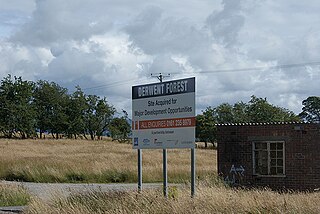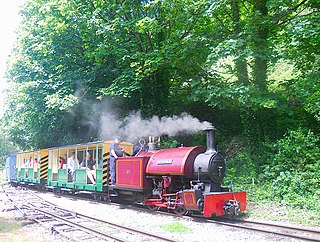
Under the Whyte notation for the classification of steam locomotives, 0-4-0 represents one of the simplest possible types, that with two axles and four coupled wheels, all of which are driven. The wheels on the earliest four-coupled locomotives were connected by a single gear wheel, but from 1825 the wheels were usually connected with coupling rods to form a single driven set.

The Tanfield Railway is a 4 ft 8+1⁄2 instandard gauge heritage railway in Gateshead and County Durham, England. Running on part of a former horse-drawn colliery wooden waggonway, later rope & horse, lastly rope & loco railway. It operates preserved industrial steam locomotives. The railway operates a passenger service every Sunday, plus other days, as well as occasional demonstration coal, goods and mixed trains. The line runs 3 miles (4.8 km) between a southern terminus at East Tanfield, Durham, to a northern terminus at Sunniside, Gateshead. Another station, Andrews House, is situated near the Marley Hill engine shed. A halt also serves the historic site of the Causey Arch. The railway claims it is "the world's oldest railway" because it runs on a section dating from 1725, other parts being in use since 1621.

The Lincolnshire Wolds Railway (LWR) is a heritage railway based at Ludborough station, near Louth, Lincolnshire, England and the only standard gauge steam railway in Lincolnshire open to the public. The line is part of the original Great Northern Railway (GNR), a rail system that opened in 1848 and once linked Grimsby, Louth and East Lincolnshire with London. In early 2002, 2009 and 2013 the Lincolnshire Wolds Railway received a top national award from the Heritage Railway Association for its heritage railway efforts.

The Hunslet Engine Company is a locomotive building company, founded in 1864 in Hunslet, England. It manufactured steam locomotives for over 100 years and currently manufactures diesel shunting locomotives. The company owns a substantial fleet of Industrial and depot shunting locomotives which are available for hire. The company is part of Ed Murray & Sons Ltd.

The Cholsey and Wallingford Railway is a 2+1⁄2-mile (4 km) long standard gauge heritage railway in the English county of Oxfordshire. It operates along most of the length of the former Wallingford branch of the Great Western Railway (GWR), from Cholsey station, 12 miles (19 km) north of Reading on the Great Western Main Line, to a station on the outskirts of the nearby town of Wallingford.

The Elsecar Heritage Railway (EHR) is located on the southern part of the former South Yorkshire Railway freight-only branch which ran from Elsecar Junction on its Mexborough to Barnsley Line.

Rutland Railway Museum, now trading as Rocks by Rail: The Living Ironstone Museum, is a heritage railway on part of a former Midland Railway mineral branch line. It is situated north east of Oakham, in Rutland, England.

The Bala Lake Railway is a narrow-gauge railway along the southern shore of Bala Lake in Gwynedd, North Wales. The line, which is 4+1⁄2 miles (7.2 km) long, is built on a section of the former standard-gauge Ruabon–Barmouth GWR route that closed in 1965. Another section of the former permanent way is used by the Llangollen Railway. The Bala Lake Railway, which runs on 600 mm -gauge preserved rolling stock, is a member of the Great Little Trains of Wales.

The Northamptonshire Ironstone Railway Trust operates a 1+1⁄2-mile (2.4 km) long heritage railway line at Hunsbury Hill, south-west of Northampton. The line is mainly dedicated to freight working, featuring many sharp curves and steep gradients which were typical of the industrial railway, but rides are available in a variety of vehicles including a converted brake van.

The Telford Steam Railway (TSR) is a heritage railway located at Horsehay, Telford in Shropshire, England, formed in 1976.

Ruston & Hornsby was an industrial equipment manufacturer in Lincoln, England founded in 1918. The company is best known as a manufacturer of narrow and standard gauge diesel locomotives and also of steam shovels. Other products included cars, steam locomotives and a range of internal combustion engines, and later gas turbines. It is now a subsidiary of Siemens.

The Scottish Industrial Railway Centre is an industrial heritage museum operated by the Ayrshire Railway Preservation Group. The centre owns a number of standard gauge steam locomotives and diesel locomotives as well as some narrow gauge items and an extensive collection of photographs.

The Northampton and Lamport Railway is a standard gauge heritage railway in Northamptonshire, England. It is based at Pitsford and Brampton station, near the villages of Pitsford and Chapel Brampton, roughly 5 miles (8.0 km) north of Northampton.

Yaxham Light Railway is a 2 ft narrow gauge light railway situated adjacent to Yaxham railway station on the Mid-Norfolk Railway. It is located in the village of Yaxham in the English county of Norfolk. The railway is listed as exempt from the UK Railways (Interoperability) Regulations 2000.

Southall Railway Centre is a non-publicised railway heritage centre at Southall in west London, near Southall railway station and the Grand Union Canal. Formerly of the Great Western Railway, the site is now run partly by Locomotive Services and West Coast Railways, both of whom lease the site from Network Rail. The location is not open to the public.

The Pallot Steam, Motor & General Museum is a mechanical heritage museum located in Rue De Bechet in the Parish of Trinity on the island of Jersey.
There have been two railways within the state territories of the Bailiwick of Guernsey, a British Crown Dependency comprising six inhabited islands.

The Yeovil Railway Centre is a small railway museum at Yeovil Junction on the L&SWR West of England Main Line between Salisbury and Exeter in the U.K.

RNAD Broughton Moor is a decommissioned Royal Naval Armaments Depot located between Great Broughton and Broughton Moor in the County of Cumbria, England.

The Amberley Museum Railway is a 2 ft narrow gauge railway based at Amberley Museum, Amberley, West Sussex. It has a varied collection of engines and rolling stock ranging from 18 in gauge to 5 ft 3 in gauge. It operates passenger trains at the museum using a mixture of steam, internal combustion and battery-electric locomotives.





















